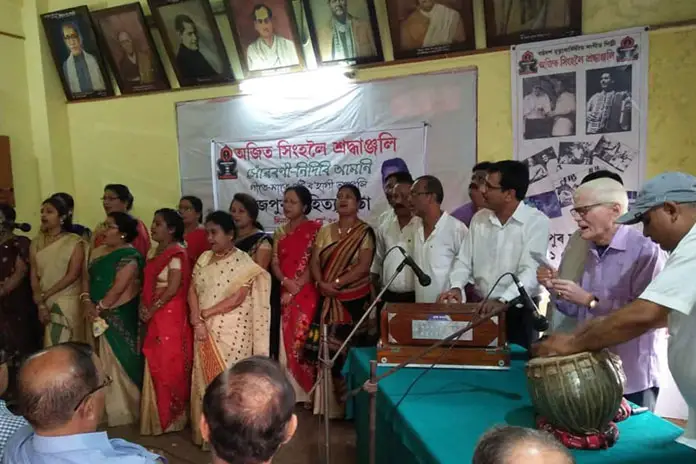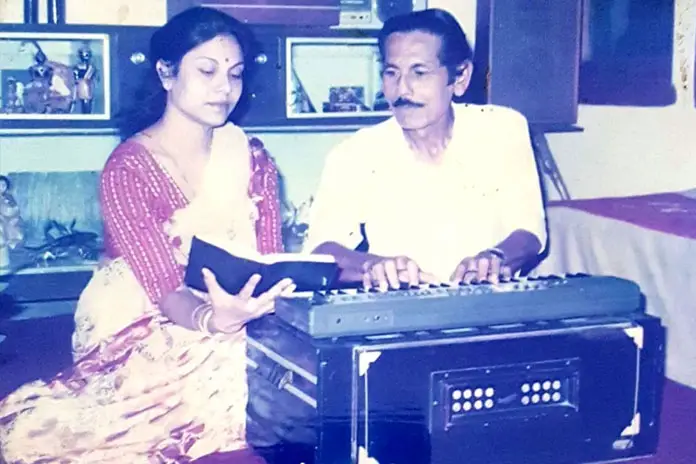The Tezpur chapter of the Asam Sahitya Sabha, the apex literary body of Assam, paid glowing tributes to the eminent music director, lyricist and actor – Ajit Singha by observing his 16th death anniversary at the Tezpur Sahitya Sabha Bhawan, recently.
The commemoration programme, christened as ‘Xuoroni-Nidibi Amoni, Geetey-Matey Ati Bohagi Abeli’, began with the lighting of the traditional lamp by the well-known singer-lyricist and wife of the late artiste, Ruby Singha, followed by the release of the audio album ‘Tumar Xuror Smritit’ – a compilation of chorus tracks, composed by Ajit Singha, by the Deputy Commissioner of Sonitpur, Narshing Powar, in the presence of several noted guests, including local MLA Brindaban Goswami, artiste Bankim Sharma, litterateur Hemanta Kumar Baruah, Nalini Baruah, Nripen Hazarika, among others.
On the occasion, everyone, including Narshing Powar, Brindaban Goswami, Pankaj Bordoloi, among others, spoke about the achievements of the eminent artiste. Hemanta Kumar Baruah, who knew the composer intimately, enumerated his manifold contributions – from music to theatre to film – bequeathing a cultural legacy, which continues to inspire people across generations.
The influential artiste, a Tezpur native, who left for his heavenly abode on May 11, 2003, played a vital role in promoting the unique cultural heritage of Tezpur. All throughout his life, Ajit Singha was quite vocal for keeping Tezpur – his birth place, and which influenced his temperament and outlook, culturally vibrant.

It was largely due to the efforts of Ajit Singha that chorus songs acquired popularity in Assam. A lot of ‘humming’ and ‘chasing’ was applied in his chorus compositions, which was quite stylish in nature and ahead of its time. His music direction in movies like Kamal Narayan Choudhury’s ‘Bhaity’ – the first Assamese colour film, Jones Mahalia’s ‘Duronir Rong’, A.K. Films’ ‘Ganesh’ and Prafulla Barua’s ‘Bansadhar’ spawned several hits, besides adding emotional intensity and impetus. He had also composed music for documentaries and a number of plays, most notably the plays of Jyotiprasad Agarwala, which were staged at the famous Ban Theatre.
Singha, who underwent training in classical music under Kishori Mohon Chakravarti and modern songs under Siba Bhattacharjya, acted as a child artiste, playing the role of Rafique in the film ‘Siraj’ (1948), directed by Phani Sarma, along with Bishnu Prasad Rabha. Prior to the coming into existence of Akashvani Guwahati, he sang two songs as a child, composed by his musical guru Siba Bhattacharjya – ‘Netai dhubonire ghat O’ Beula’ and ‘Bonore marami’, in a radio programme – Semoniya Sora, which was telecast from Kolkata. After stints at acting on stage, he landed the leading role opposite the popular actress Eva Asao in Phani Sarma’s ‘Kesa Xun’ (1959), featuring the music of Dr Bhupen Hazarika, where he played the character of Ram.
Some of his most prominent audio albums, to name just a few, were ‘Suror Smritit’, ‘Bandhu’, ‘Muhonia’, which was a compilation of his movie songs, and albums featuring the evergreen songs of Kalaguru Bishnu Prasad Rabha – ‘Indradhanu’, produced by the Directorate of Cultural Affairs, and ‘Bishwar Chande Chande’, produced by the Jana Sanskritik Parishad, where Singha stressed on the importance of pronouncing and interpreting the words correctly, as he always stressed on the artistic union of word and tone. The album ‘Joi Aai Asom’, which was recorded in a room designed as a soundproof studio at his own residence during the Assam Agitation, was the first private non-commercial audio cassette of Assam. The concept of playing live music in the orchestra pit, which was prevalent during the times of Jyotiprasad Agarwala, but ceased to exist for long, was revived and restored to resounding effect by Singha. It helped to focus on the emotions and expressions of the artistes, in addition to getting a better grip of the dramas.
It was his better-half Ruby Singha, a prominent singer-lyricist in her own right, who recognised the amazing potential of the artiste, and went on to play a noteworthy role in his artistic endeavours. Apart from rendering a number of songs composed and tuned by Ajit Singha on radio, she has done playback singing in ‘Ganesh’ and ‘Bansadhar’, and has written a number of songs, including the evergreen ‘Moi aji xongibihin’ (Duranir Rong), in Pulak Banerjee’s voice, ‘Tumi mur uthor bhaxa’ (Bansadhar), rendered by Anjali Kataki, ‘Bhakatire Bonti Jolai’ (Bansadhar), in the voices of Anjali Kataki, Sangeeta Singha and herself, among others. She has also sung a number of songs composed by Ajit Singha in albums with their daughter Sangeeta Singha, a talented singer, including ‘Bihu Bihu Lagise Gaat’ (1983) – an HMV release, which also featured Dr Bhupen Hazarika, and ‘Tumar Xur’, which had the voice of Jitul Sonowal. In the year 1999, Ajit Singha was honoured with the much deserved Kalaguru Bishnu Rabha Bota.
The tribute function was presided over by Dr Bhupen Saikia, president of Tezpur Sahitya Sabha, conducted by journalist Pankaj Baruah, while Debabrata Sarma, secretary of Tezpur Sahitya Sabha, gave the welcome speech. The evening also saw a chorus performance by the members of the Tezpur Sahitya Sabha, followed by renditions of songs composed by Ajit Singha, rendered by Sachinanda Bora, Pankaj Bordoloi, Pranjal Saikia, Pawan Das, Kamakhya Bora, Bitopan Bora, Anwesa Kanchan Bora, Kamaikhya Bora, among others, which regaled the audience.

